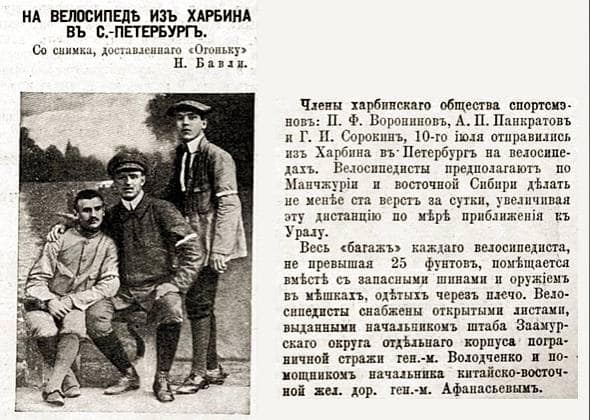On August 23, 1913, in the city of Harbin, a 25-year-old Russian cyclist named Onisim Pankratov completed his circumnavigation journey, becoming a future military pilot and hero of World War I.
The idea of undertaking a round-the-world journey was suggested to the young man by his father, and the aspiration to turn this cherished dream into reality was driven by an article in the newspaper. It was reported there that as far back as 1896, the International Cycling Federation had established a diamond palm branch for the athlete who would be the first to cycle across all of Europe.
In three years, Onisim saved money and purchased a lightweight touring bicycle. Sports organizations supported Pankratov’s idea, and in the early summer of 1911, a festive send-off was held.
At the beginning of the route, three more cyclists joined Pankratov on his journey, but they soon dropped out.
This was the first bicycle journey around the entire planet. Pankratov chose not the shortest, but a rather complex route that took him through nearly all European countries. In late November 1911, he arrived in St. Petersburg, then via East Prussia, Switzerland, Italy, Turkey, Greece, Turkey again, Italy again, France, southern Spain, Portugal, and northern France, he reached the shores of the Pas-de-Calais strait. On a ferry, the cyclist crossed to England, from where he sailed to North America, and after «cutting» across it from east to west, he sailed from San Francisco to Japan. From there, it was just a stone’s throw away to China.
While traveling outside of Russia, Onisim constantly sought opportunities to earn money for continuing his journey. In England, Russian writers helped him publish travel notes. He also participated in numerous wrestling and cycling competitions. In America, he had to work as a stevedore at the port to buy a ticket for a ship.
At the finish line, the hero was awarded a laurel wreath of victory and expressed confidence that his record, while being the first, would by no means be the last.
The entire journey took him 748 days. During this trip, the cyclist changed 53 tires, 4 saddles, 2 handlebars, 11 chains, and 750 spokes.
At the end of 1913, the International Cycling Federation awarded him an honorary prize.
Interestingly, from the bicycle, Pankratov transitioned to… an airplane. He had contemplated undertaking a circumnavigation journey by aircraft, but his plans were disrupted by World War I. After training at the Gatchina Aviation School, Pankratov was sent to the front. He became one of the most successful Russian aviators. He was employed both as a reconnaissance pilot and a bomber, and he was credited with shooting down enemy planes. The fact that Onisim fought bravely is evident from such a fact: within a year and a half on the front, he became a full-fledged Order of St. George knight and was promoted to the rank of lieutenant. His final battle took place on September 5, 1916, near Dvinsk. In an uneven aerial combat, Pankratov shot down two German planes but didn’t manage to evade the third, which came up from behind.


